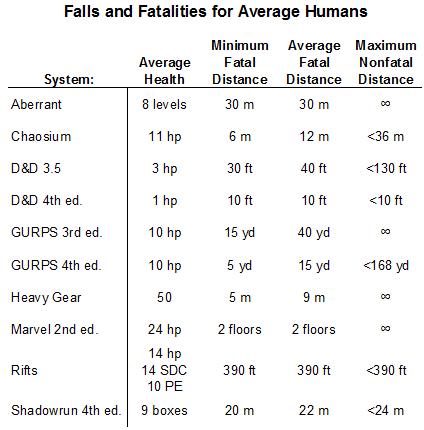This is the first of several posts I have planned about simulating the results of falls from elevations. Here I simply determined the minimum distance necessary to fall for an average human to die, the distance at which an average person would die on average, and the maximum distance that an average person could fall without dying for ten different systems.
As you can see, there are wide differences among systems. The grades I give are subjectively based on how each mechanic models reality and contributes to game balance.
- Aberrant: For any fall under 30 meters, even the most feeble person has a 99.6% chance of only sustaining minor injuries that will heal in a day (bashing damage). At 30 meters, damage becomes lethal and maxes out at 10 dice (an average of 4 levels of damage), with only a 1.3% chance of dying even when falling miles. F
- Chaosium: Average health is actually 12hp, not 11, but the distances are correct. 1d6 damage for each 3 meters gives us a nice distribution of injuries and chances of death up to the assured death point at 36 meters. B
- D&D 3.5 (OGL): The average human in this system has 1d4 hp, which I round up to 3, but does not die until reaching -10 hp. Most falls that are not immediately fatal will still result in wounds that may result in a person's eventual death if not stabilized, but I did not calculate that. B
- D&D 4th ed.: The most appropriate stats I found for a non-heroic person in this game were for "Human Rabble", who have 1 hp. At 1d10 damage for each 10' fallen, everybody dies from any fall of at least 10'. D
- GURPS 3rd ed.: Damage involves rolling 1d6 and subtracting a constant for each yard fallen. Since it is possible to roll the constant or less on each 1d6, it is possible to take no damage at all when falling from any height. Instant death requires 6xHealth damage in the GURPS systems. D
- GURPS 4th ed.: Now there is an equation for determining how many d6 to roll based on velocity. GURPS in one of the few systems that takes acceleration into account instead of just distance. A-
- Heavy Gear: Roll 1d6 for each meter up to 10 meters, and multiply the result by meters fallen up to 30. Remember that the Silhouette system is funky, so "result" means the highest number rolled among the dice, and additional 6s each add 1 to the first 6. It is possible (ridiculously unlikely) to roll all 1s and survive any fall. It is also possible (ridiculously unlikely) to roll all 6s and die falling 5 meters. An average person has a 40% chance of death falling 8 meters, and an 81% chance of death falling 9 meters. B-
- Marvel Super Heroes 2nd ed.: The rules as written were clearly not proofread or edited. They make absolutely no sense in the English language. On page 21 the rules say to take 1 point of damage for each floor fallen (a person would have to fall 24 floors), but also say to treat falling as a charge attack. Charge attack rules on page 27 gave me the numbers I use for this post. Using the Empire State Building for reference, I decided that a "floor" is 12 feet. F
- Rifts: People take 1 point of damage for each 10' fallen. Instant death is at -(PE+1) hp. A healthy average person will survive any fall under 390'. F
- Shadowrun 4th ed.: I did not find stats for an average human. Humans have 1-6 body points, bought up from 1 at character creation. Looking at sample characters, I figured that an average human has a body of 2. Damage from falls over 6m is about (distance+4)/2, and characters roll (Body)d6 to resist some damage. For someone with a Body of 3, the distances are 22m, 24m, 28m. C
- 7th Sea: This is a game focused on dramatic swashbuckling stories, and seems to not have rules for falls.






